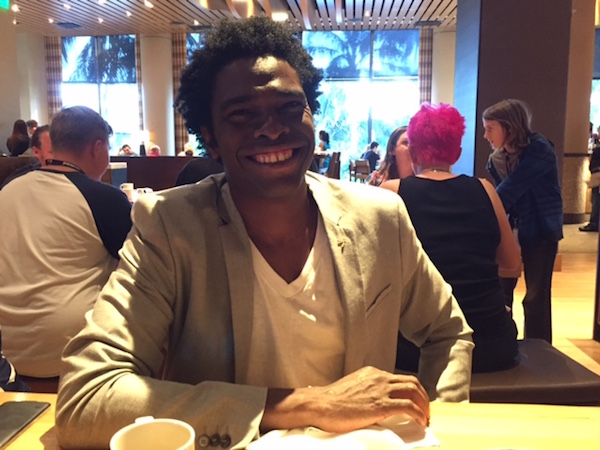
Interview: Johnnie Christmas on ‘Angel Catbird’
Novelist Margaret Atwood struck out in a new direction this year with her graphic novel series Angel Catbird, which is being published by Dark Horse; the first volume came out earlier this month. I interviewed Atwood at Comic-Con International in San Diego, and at the same time I also spoke to Johnnie Christmas, the artist for the book. Christmas has been working professionally since 2012 and was the artist for Shelter, which was published by Image Comics, as well as his current series, Firebug.
Sometimes when you have a well known writer, the comic ends up being like an illustrated novel. In this book, I feel like the art really does a lot of the storytelling work, in terms of the way it’s told, the paneling, even little details like when Feedus [the main character] first wakes up, he stretches like a cat. How did you and Margaret collaborate?
ADVERTISEMENT
ADVERTISEMENT
In the script she would have descriptions like “He stretches out like a cat.”
Do you have cats?
I don’t. A lot of cartoonists will tell you—or maybe they won’t tell you—but what happens a lot is you do a lot of acting in your studio. I have a giant mirror and I act out a lot of scenes, just so I can get a look and feel for how things are. I’m always making faces in the mirror and doing strange stretches and what have you. Disney animators did that too—you can see old videos of them doing stuff. You have to feel it and be in the moment when you’re creating it and sustain that emotion or action to sell it believably, so a lot of that is just acting it out and trying to get in the mind of the characters and how would they do it and how would I feel.
 How did you create a believable character that was part human, part cat, and part bird?
How did you create a believable character that was part human, part cat, and part bird?
With tons of sketches. At first I wasn’t sure if she wanted him more catlike, because I knew that most of the people in the world would be cats or half-cats. The first version was more cat-like with wings etc., and then when Margaret sent back notes saying “We want a little bit more owl, with ears, the markings,” I went back in for a second pass, and the second pass was the one we went with. [Feedus] had more owl type features but was also very cat-like in his look. I didn’t want it to be too owly at that point, because he has ears and markings and wings, so we kept the claws and the fangs. The way I think about him in my head is he moves more cat-like than owl-like, and then when he is taking flight he is more owl-like.
Was it intimidating working with Margaret Atwood?
It wasn’t. At first, before we started working together, that was sort of intimidating, becuse I didn’t know what to expect. Once we started working on it, the legend of Margaret Atwood receded and the person emerged, so now I’m just working with Margaret. There’s not a great expectation to live up to or anything like that, and she is very warm and friendly, so it’s not intimidating at all.
So do you ever say to her “Margaret, that’s a terrible idea!”?
No, but I’ll suggest ideas, like how about this, or maybe it would be more punchy if we did this instead. She takes notes and if she agrees we will go with that, and if not, we’ll do it the way she originally proposed it.
What’s the biggest challenge of creating this visual story?
Trying to get an understanding of the tone. We didn’t have too many conversations about tone right off the top, so I wasn’t quite sure if going to be a very serious tale or if it was going to be a humorous tale. It was only after the scripts started coming in that I realized “OK, this is what we are working with,” and I was able to go with it that way. So that was the hardest part—getting a foothold.
It sounds like your other books comics are fairly adult. Did you change the tone of your art, or your approach, in any way because this is an all ages book?
I have had to simplify a bit. I’ve been leaning on my illustration training to simplify but clarify, so leaning toward more iconography instead of representation. Instead of layering line after line after line, it’s more clean, direct communication through simplicity of line. I’ve had to change up the way I communicate and make it more direct.
Filed under: Interviews
About Brigid Alverson
Brigid Alverson, the editor of the Good Comics for Kids blog, has been reading comics since she was 4. She has an MFA in printmaking and has worked as a book editor, a newspaper reporter, and assistant to the mayor of a small city. In addition to editing GC4K, she is a regular columnist for SLJ, a contributing editor at ICv2, an editor at Smash Pages, and a writer for Publishers Weekly. Brigid is married to a physicist and has two daughters. She was a judge for the 2012 Eisner Awards.
ADVERTISEMENT
ADVERTISEMENT
SLJ Blog Network
Name That LEGO Book Cover! (#53)
Cover Reveal and Q&A: The One and Only Googoosh with Azadeh Westergaard
Fighting Public School Book Bans with the Civil Rights Act
ADVERTISEMENT








